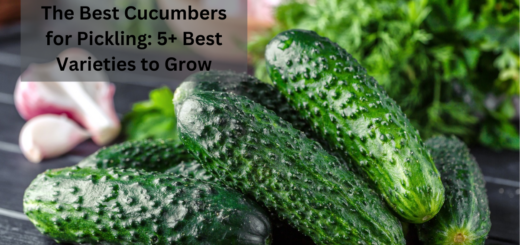What is Marrow Squash? How to grow Marrow Squash Vegetables?
What do you think after hearing the word “marrow”? You must be thinking of the soft fatty substance present in bones, but here’s another kind that you need to add to your vocabulary: marrow squash or vegetable marrow.
Don’t know what marrow squash is? How to grow them in your garden? Don’t worry, here I am to help you.
I have explained all the necessary guides that will help you to know about marrow squash and plant them in your garden. Furthermore, if you encounter any problems while growing them, don’t hesitate to ask me in the comment section below.
Key takeaways:
- Marrow squash, sometimes known as vegetable marrow, is botanically and gastronomically related to zucchini.
- Marrow squash has a mild taste that is similar to zucchini.
- It has a light green, speckled skin, and white meat, and may grow up to the size of a watermelon.
- Marrows and squashes are adaptable vegetables that may be roasted, cooked, or stuffed, and they add flavor to any dish.
- Butternut squash has a sweet golden flesh that is quite appetizing.
- Mature winter squash may be kept for several months in a cold spot. some examples of winter squash are Pumpkin, Spaghetti Squash, Delicata squash, Acorn squash, etc.
What exactly is Marrow?
Marrow is classified as a cucurbit, which means it belongs to the same family as melon, cucumber, squash, and courgette. Marrow is a zucchini that has been left on the vine to grow a bit longer; similarly, if you take a marrow when it is little, it is classified as a courgette. Marrow has a mild flavor, and creamy meat, with edible skin and seeds.
Marrows and courgettes are the same things: if you let a courgette grow too large, it will turn into a marrow! If you wish to cultivate marrows, you should select a variety that has been particularly developed for this purpose.
To be self-sufficient in these prodigious producers, most households only require 1 or 2 plants of each.
Growing Marrow
Marrows and squashes require a shady spot in full light, as well as healthy, moisture-retaining soil.
They are huge, spreading plants that require plenty of space, with spacing ranging from 90cm to 1.2m (3-4ft). There are also compact variants available.
They should be cultivated in planting pockets for the greatest results. Dig a 30cm (12in) square and deep hole 2 to 3 weeks before planting seeds or planting out, and fill with a mix of compost or well-rotted compost and soil. Leave a slight mound at the top and cover the soil with a general granular feed. Marrow can be steamed, baked, boiled, fried, or roasted. The stripy skin is edible, but if roasting or frying, remove the seeds and stringy lower middle so you can only eat the meat.
Sowing Marrow Squash Vegetables
Sow the seeds 13mm (1/2in) deep in 7.5-9cm (3-31/2in) pots of seed-spreading compost from mid-to-late April for the best results. Place the pots in a composter or another warm location, you have to keep the pots warm, where the temperature stays between 18 and 21 degrees Celsius (65 and 70 degrees Fahrenheit). After the threat of frost has gone, harden off the young seedlings for 7-10 days before sowing outside in late May/early June.
In late May or early June, put 2 or 3 seeds 2.5cm (1in) deep in the planting pocket and cover it with a cloche or jam jar. Remove the weakest seedlings from the group of young seedlings.
Tips for planting marrow squash:
The following are some tips for planting marrow Squash in your garden:
- you need to show the seed in small pots deeply or you can use deep seed trees. the perfect depth for showing the seed is about 20 mm deep. the right time for showing the seed in the soil is after the last Frost.
- Make sure to give them a space of about 90-120 CM between the plants and about 90 cm space between rows of marrow squash.
- the right time for harvesting the plant is 12 to 17 weeks after planting and you can also continuously collect the fruits as the plant is used to grow and eaten.
- Provide the plant with full Sunlight or partial shade to grow in hot areas. you need to provide the plant with rich well-drained soil and also apply a covering of mulch so that the weeds don’t grow out there and the soil is good in maintaining the moisture.
- You need to provide the plants with extra watering at the base of the plant especially in hot dry weather.
- Get the plant with to be feeding plants which will help to produce a good harvest.
- The soils need to range the pH from 6 to 7 such as neutral to slightly acid soils.
- Pot the plants in Large pots or containers so that they grow perfectly.
- If you avoid watering the leaves there will be less chance of growing powdery mildew.
- You can also dig a small hole near the plant and fill the with compost and add some water so that the water reaches the root of the plant, not the plant’s stem or leaves will not get wet.
Problems with marrow:
There are some problems with marrow squash that you can get while growing them in your garden such as:
- There is a high chance of fruits not getting to bloom.
- You may suffer from failure to bloom in fruits.
- There will be a failure to fertilize the bloom fruit and flowers only if you plant them in too-rich soil or a shady place mainly during dull, and damp summers.
- You need to thin out a few shoots of the plant so that the plant gets air and sunlight.
Pollinating the marrows:
In case there is cold wet or windy weather outside then there is less chance of natural pollination being successful. So you need to process hand pollination which will be the best option for that situation. I will suggest you hand pollinate the plants which are planted under the glass. The female flower is used to swell below the bloom and the male flower has a prominent Central Core that holds yellow Pollen. You will observe that the male flower will Bloom first and the female flower will Bloom after the blooming of the male flowers.
The process of hand pollination is done by removing the Petals from the male flower and then pushing the core of the male flower into the center of the female flower. To get accurate results you can use different male flowers in each female flower.
Caring for Marrow Squash Vegetables
If the weather gets cold, cover the young plants with fleece or a bonnet to protect them from frost and cold.
Water the soil around the plants – not above them – as needed to keep it wet. Feed with a rich potash liquid feed every 10-14 days as the first fruit begins to swell.
Pinch out the ends of trailing types’ main branches when they reach 60cm (2ft) in length or three fruits have set.
To keep the fruit clean, avoid rotting, and let them mature correctly, it may need to be supported off the ground on a piece of wood or a tile.
Harvesting
Marrows and summer squash should be picked when they are still young for immediate use; marrows should be 23-30cm (9-12in) long. Cutting the plant regularly should guarantee that it bears fruit for a long time.
Cut winter squashes right before the first winter in the fall and let them mature on a sunny windowsill. The skin will get thicker and darker.
For more such plant related-articles, you may also read, What Is Broccoli Di Ciccio? – Plant and Care for Di Ciccio Broccoli
Storing
Marrows and winter squash should be stored in a cool, frost-free area such as a shed or garage. Winter squashes can be stored until Christmas or the New Year if properly matured.
Pests
Poor fruit set and immature fruit rotting are two issues that marrows and squashes may face.
About the article
Marrow is classified as a cucurbit, which means it belongs to the same family as melon, cucumber, squash, and courgette. Marrow is a zucchini that has been left on the vine to grow a bit longer; similarly, if you take a marrow when it is little, it is classified as a courgette. Marrow has a mild flavor, and creamy meat, with edible skin and seeds.
FAQ’s
Is Marrow squash easy to plant?
marrow squash is considered easy to plant only when they have started to grow and run.
What is marrow known in America?
They are commonly known as Courgette or Zucchini.


